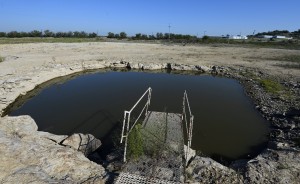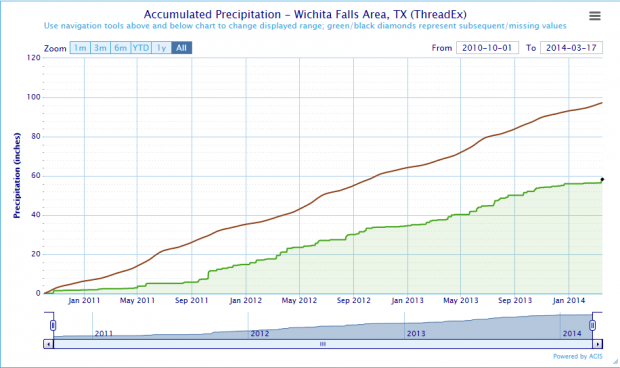Next 3 Months ‘Huge’ In Preventing Brutal Texas Summer

EPA/LARRY W. SMITH /LANDOV
A small pool of water is all that remains in a portion of Bridgeport Lake in September 2013.
Texans looking for relief from the drought are eagerly anticipating the chances of an El Niño event starting this summer, which could bring much wetter conditions. But the focus should actually be on the near-term, according to Victor Murphy, climate service program manager for the National Oceanic and Atmospheric Administration in Fort Worth. Murphy says that the next three months, April, May and June, will be crucial to staving off another critically dry—and hot—summer.
April, May and June are typically the wettest months of the Texas year, and little to no rain could lead to dry soil and hot days.
“What happens during those three months, between now and June, is going to be just huge going forward into the summertime, but unfortunately we do not have any kind of a clear climate signal to hang our hats on with regards to making a forecast,” he said.
The bad news—Murphy says—is that right now, the weather forecast for the next three months has equal chances of below normal rainfall, near normal rainfall, and above normal rainfall.
The state’s reservoirs are only 65 percent full, their lowest level for this time of year in decades. Murphy says if El Niño does occur, and Texas is hit with lots of precipitation as a result, it could be enough to bring the majority of the state out of the drought.
A recent study from Stanford University put the chances of El Niño returning at 76 percent. Murphy believes it’s lower than that, but if it does come back, the rainy aftermath won’t be felt until the winter.
“It’s going to take quite a bit of precipitation above normal to get Texas completely out of the drought, but I think parts of the state that are sort of fringe-y as far as drought goes…could probably work their way out of it,” he says.

Victor Murphy / National Oceanic and Atmospheric Administration
Precipitation records for the last three years in Wichita Falls, Texas, one of the areas hit hardest by the drought. The brown line is the expected precipitation level, and the green area is actual levels.
However, according to Murphy, even with El Niño, areas of the state hit hardest, like the Texas panhandle, might never see total recovery from the drought, which began in October 2010.
